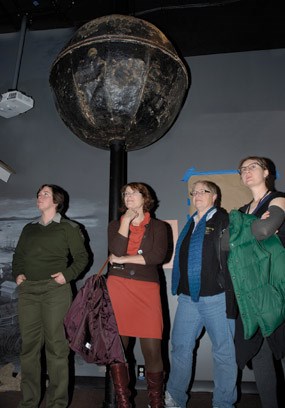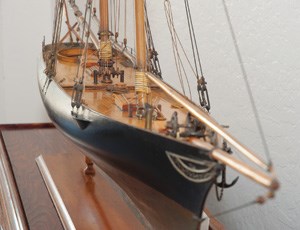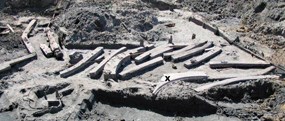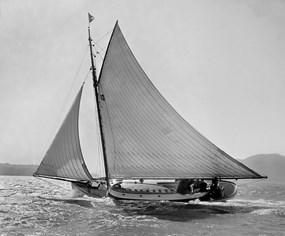
San Francisco Maritime NHP, HDC0005 (SAFR 14022), folder 2 San Francisco though Letters and Stories
By Chris Gordon Library and Information Sciences Master's Program Simmons University |
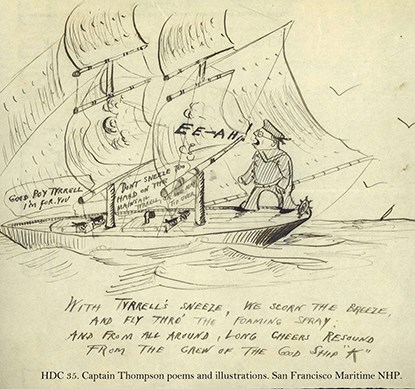
NPS, HDC 35, SAFR 17607 Poetry in Ocean A brief look at rhymes and verse in the archival collections of San Francisco Maritime NHP. 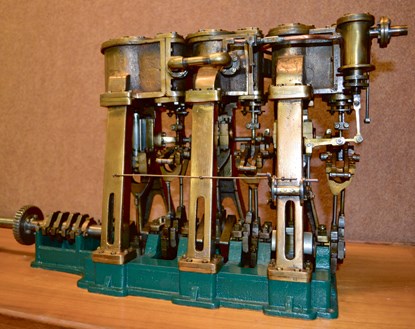
NPS, SAFR 8775 Check out this pretty, little gem -- a model of a triple-expansion steam engine. 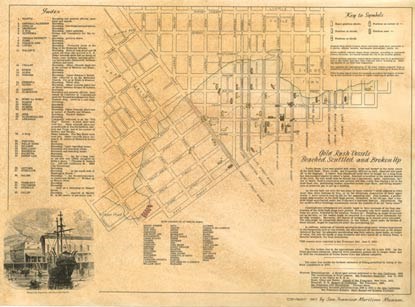
NPS SAFR T.41,412N Journals Written by George S. Payne Detail His 1835-40 Voyages Aboard the Niantic 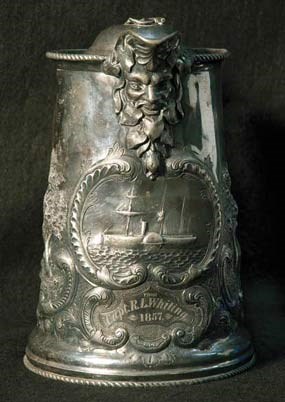
NPS Photo A Silver Link To Our Golden Past With each new donation, a new piece of a giant jigsaw puzzle is found and fit into place, revealing a bit more of the historical picture. 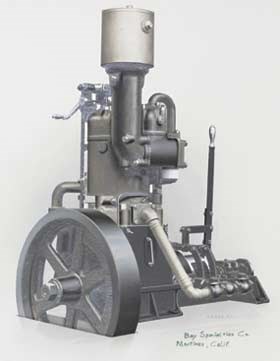
NPS, SAFR 17336, HDC 1092 Discover the Hicks Marine Engine Archival Collection 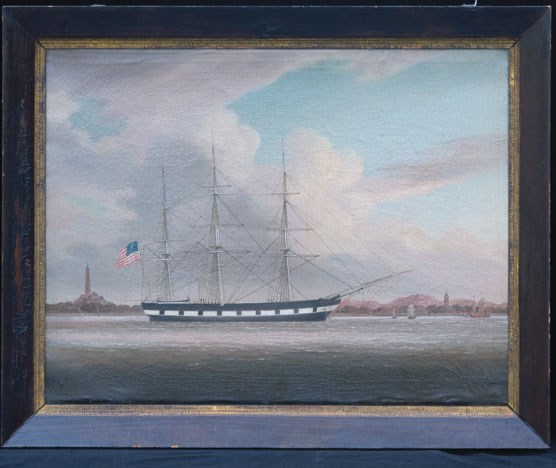
NPS, SAFR 22386 Read the fascinating story of the NIANTIC, a Gold Rush ship. 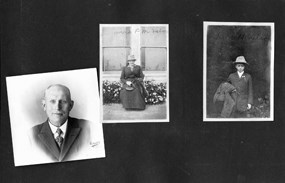
NPS Photos Hilda Nelson's Family Photo Album You just never know what treasures are lurking in peoples’ closets and attics. And last December, with the help of the great granddaughter of the owner of a lumber schooner, the park made an exciting discovery. 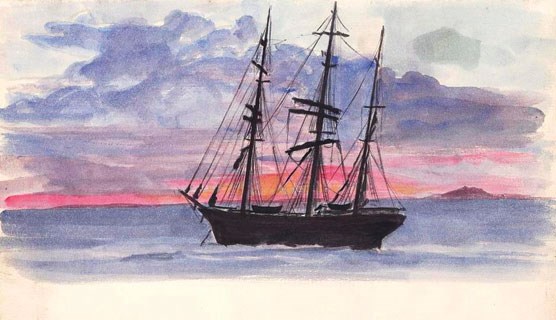
NPS Photo
John Milton Ramm By Jocelyn Park, Museum Technician San Francisco Maritime National Historical Park houses a diverse collection of drawings, watercolors, and ephemera by John Milton Ramm. Born in 1904 in San Francisco, Ramm was a muralist and painter focusing on a variety of genres, including maritime. His artistic endeavors stemmed from his father, John Henry Ramm, who was a painter and photographer, renowned for his illustrative documentation of the 1906 earthquake. Ramm attended Lowell High School in San Francisco, and continued his studies at the California School of Fine Arts. After graduating, he travelled the world on merchant ships from 1923 to 1938, utilizing his artistic talents as he documented his surroundings with drawings and paintings. Much of his artwork was inspired and produced during his time at sea on merchant ships. The watercolor painting shown above captures what he saw on a voyage. It is the port side view of the bark, Lina, anchored at Accra, Ghana with a dusk-filled horizon behind it. His style shows naturalism and the ship is drawn with accuracy. Time spent at sea influenced his other artwork. He produced advertising material for San Francisco steamship companies and rendered various ephemera such as holiday greeting cards many of which include ships, sea animals, and maritime themes. During World War II, Ramm employed his talents as an engineering draftsman and shipfitter. Most of his life was either spent at sea or in the San Francisco Bay Area. He died in 1984 in Alameda. The John Milton Ramm collection is available for scholarly investigation and research by appointment. Images of his work are available on the National Park Service Web Catalog www.museum.nps.gov/safr/page.htm 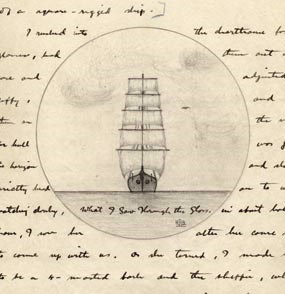
NPS HDC 108 SAFR 14315 By Lisbit Bailey, Museum Curator When people write down their stories, it captures the past. The museum and archive collections of the park contain many personal accounts in the form of journals, logbooks, and letters. When we read these personal accounts, we can imagine what life was like traveling on the world's oceans from the days of the Gold Rush to the recent past. The archivists at San Francisco Maritime National Historical Park preserve, protect, and ensure we have access to these valuable first-hand experiences. Museum Curator Lisbit Bailey has selected three of her favorites. The Log of the Ship Apollo, 1849. This rough log was neatly written in pencil by Joseph Perkins Beach, the son of the owner of the Apollo. He kept a daily record from January 16, 1849 to November 12, 1849 during his Gold Rush voyage from New York to San Francisco. Sketches in the log include fish seen and caught, including sharks and a "double headed sun fish." The entry for August 1, 1849 reads: "Commenced with light winds and pleasant weather. Through the night, rainy & light breezes. Latter part light airs and pleasant weather. It is equal to a play to see the vain endeavors our passengers make to sleep on deck. Tormented by ten thousand fleas. They are still further annoyed by the wakefuls who fasten strings to their feet . . ." A Journal of Events Made on a Voyage in the Four-masted Bark Drummuir, 1911. Henry A. Butters, an Englishman, arrived in 1906 to attend the University of California at Berkeley. Before commencing his studies, Butters became ill with pneumonia. Typical of the times, his doctor advised him to go to sea to improve his health. He boarded the Drummiur in Port Townsend, WA for his first sea voyage. Butters assembled the journal after his voyage, and included his sketches, photographs, and letters he had sent to his parents during the voyage. He describes the food: ". . . I am getting used to the fare, which helps out immensely. The coffee, which at first disgusted me, I now imbibe with much gusto; the canned fish, whose odor formerly repelled me, I look forward to as a rare delicacy and I can even go [at] the canned meat like a porterhouse steak." A Personal Letter from a Survivor of the Hospital Ship Benevolence Disaster, 1950. In 1946, the Benevolence provided medical support at the atomic bomb tests at Bikini Atoll in the Marshall Islands. In 1950, conflict in Korea caused many reserve ships, like the Benevolence, to be restored to active service. Prior to deployment, she was on a trial run in dense fog off San Francisco. About four miles off the Golden Gate, the merchant ship Mary Luckenbach hit the Benevolence, and she sank in 15 minutes. Hundreds were saved, but some civilian and naval personnel were lost. Among the survivors was Irvin T. McGuire. He wrote a letter to his wife recounting his experience. "I saw a high swell coming so I started swimming at an angle from the bow as I thought she was about to nose dive to her grave & did not want to get caught in the suction. I swam hard for a little while & cleared her then I looked back & could see her under the water & the top of the turned over lifeboat. I was alone in the fog." These and other suspenseful, and delightful, stories of our maritime past are here for your discovery. To learn more, please make an appointment to visit the Maritime Research Center by calling (415-561-7030). If you would like to view any of these accounts, ask for the Apollo log (HDC 29 SAFR 13575), the Butter's journal (HDC 108 SAFR 14315) and the Benevolence letter (HDC 1099 SAFR 14649). The park website is www.nps.gov/safr and you can explore the NPS Museum and Archives Collections online at www.museum.nps.gov/#S. 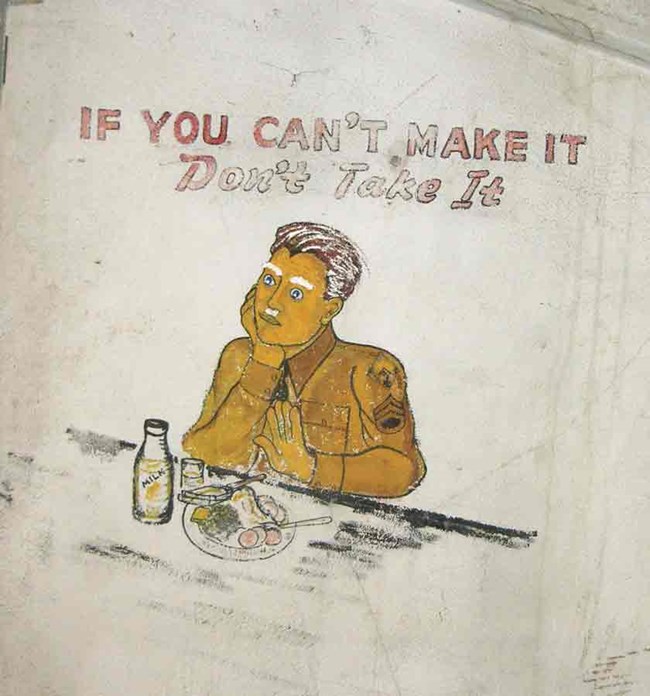
NPS Photo By Stephen Canright, Park Curator, Maritime History During World War II, the U.S. Army took over Aquatic Park as the headquarters for an anti-aircraft unit. The military controlled the park until 1948. Before returning the property to the city, they did a careful restoration, removing almost every trace of Army occupation. They did, however, leave behind a painting on a stucco wall under the east bleachers. This area has been used for storage and shop space and this modest painting has never been viewed by the public. When the current restoration of the bleachers required that the damaged east bleacher be demolished, the painted wall section was cut out. Now safely in storage, the piece will be conserved and later exhibited as a part of the history of Aquatic Park. It was five days prior to the attack on Pearl Harbor on December 7, 1941 that the Army took over Aquatic Park. Battery B of the 216th Coast Artillery Regiment moved into the main building. It also became the headquarters of the Fourth Anti-Aircraft Command. The complex was used for offices and quarters for the officers and men. The space under the bleachers served as a mess hall. The wall painting, done by an anonymous soldier probably in 1942 or ’43, exhorted the men not to waste food. While it is no masterwork, it is certainly evocative of wartime life at the site. Beginning in 1951, the space was managed by the Maritime Museum and then by the San Francisco Maritime National Historical Park. Staff were aware of the painting as an interesting bit of historical curiosity. The bleachers structure, built initially of defective materials, was damp and badly ventilated, and gradually deteriorated. As part of the Aquatic Park Rehabilitation Project, the eastern bleachers are being torn down and rebuilt, so the painting was removed. Last April, under the direction of Park Conservator Dave Casebolt, and assisted by employees Channing Walker, Bruce Vanvick and others, the entire wall section was sawn free from the surrounding structure and carefully lowered onto a padded platform. According to Dave it is, “dumb luck” that the painting survived, considering it was done in water-soluble paints on a wall under the leaky bleachers. The painting was done on a thick plaster wall on metal mesh over a wooden frame, so the back side of the painting was a crumbly, rusty piece of plaster wall. In the conservation shop, Dave applied a plastic coating that soaked into the original plaster making a firm layer. It will then be attached to a piece of lightweight aluminum backing that will serve as a suitable frame for exhibiting the work. 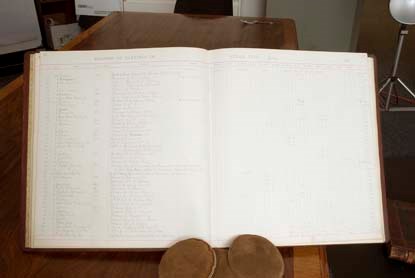
NPS Photo The park has recently acquired two very interesting ledger books produced by the Shipowners and Merchants Tugboat Company of San Francisco, the old “Red Stack” line. The two volumes cover the operations of the Company’s steam tugs between 1908 and 1913, recording each job undertaken by each boat, and what was earned for the job. The information contained in these volumes is of particular interest to the park because, during this period, Red Stack owned and operated the tug Hercules, now a treasured part of our historic fleet. Built at Camden, New Jersey in 1907, the Hercules was the newest, the largest, and the most powerful of the Red Stack boats. The ledgers give us a look, in detail, at just what the Hercules was doing during these early years of her career. Much of this is new information. Our best source previously on her early operations is a personal log book kept by the boat’s first Captain, Daniel G. “Smokestack” Thomsen, covering the period from January 1908 to July 1909, including her maiden voyage from New Jersey to San Francisco by way of the Straits of Magellan. The new ledgers, therefore, overlap in time with Thomsen’s log, and, for this period, add only limited new material. The later of the two volumes, covering the period 1911 to 1913, is all new information. The Hercules, throughout her career with Red Stack, was primarily an “outside” boat, making long coastal or even deep-ocean tows. She was often gone for weeks at a time, venturing as far afield as Tahiti, and routinely making trips to Hawaii. The bread and butter of her work was in the rapidly expanding oil transport business. Red Stack contracted with Standard Oil of California for the towage of their tank barges from San Luis Obispo to their refinery at Point Richmond. In the ledger column for receipts for many of these tows is the abbreviation “incl,” apparently indicating that the cost of the tow was “included” under a regular agreement. Hercules also towed oil barges for Associated Oil from Monterey to Martinez, most of them iron or steel sailing ship hulls converted to tank carriers. She also towed Union Oil’s wooden-hulled barkentine Fullerton. As one of the earliest oil-fired steamers to operate on the West Coast, the Hercules was intimately involved from the beginning in the petroleum business. The ledgers also indicate that Hercules made a number of trips towing Benson log rafts from the Columbia River to San Diego. These massive cigar-shaped rafts, comprising some 6,000,000 board feet of Douglas fir timber, would require about 15 days of steaming at three knots. The tug also did several trips with dredges for port improvement projects from Puget Sound to the Hawaiian Isles. These jobs were normally billed at a daily rate of $200. While in the Bay, between her outside trips, the Hercules did ship assistance work, including a tow of the Star of Alaska, another name for our own Balclutha, from Butchertown, near Hunters Point, to China Basin, in October 1911, earning herself $30. For anyone interested in the operation of a tugboat fleet during the early 20th century, the ledgers offer a tantalizing glimpse of the business. Red Stack was running eleven boats during most of this period. The record of the vessels towed or assisted, shifted among the multitude of ports, piers, and anchoring grounds around the Bay, gives us a detailed snapshot of the complex web of maritime commerce during the period, and would certainly reward the closest examination. By Stephen Canright, Park Curator, Maritime History 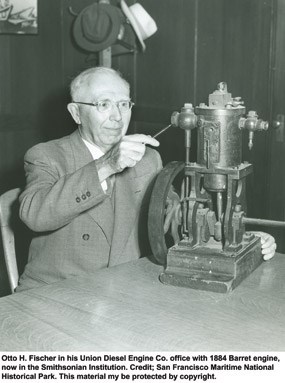
NPS Photo, P05-077 By Stephen Canright, Park Curator, Maritime History Over the past two years the park has taken in two groups of
archival materials relating to the Union Diesel Engine Company of
Formed in 1892 as the Union Gas Engine Company following a merger of the Regan Vapor Engine Company and the Pacific Gas Engine Company, it was the first successful manufacturer of gasoline engines in this country.
Daniel S. Regan was the true pioneer of the American
gasoline engine business, receiving the first
Bay Area engines were notable in the 1890s and the early
20th century for being four-strokes, at a time when two-strokes were the norm
elsewhere in the country. The Hicks and the Frisco Standard models were the
last survivors of these locally-built gasoline engines, remaining the preferred
power for
A Hicks engine, in working condition, is on display at Hyde
Street Pier. Also, moored at the end of the pier is a
The Union Gas Engine Company was located on
After developing their first diesel engine in the early 1920s, they became the Union Diesel Engine Company and remained in business until the early 1970s. Otto Fischer was the president from about 1910 until his death in 1967, and was succeeded by his daughter, Harriet Fischer Newell.
The Union Diesel Engine Co. collections are available for research. Call the Park Research Center for information, 415-561-7030. 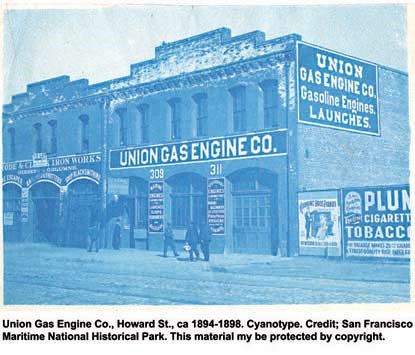
NPS Photo, P05-077 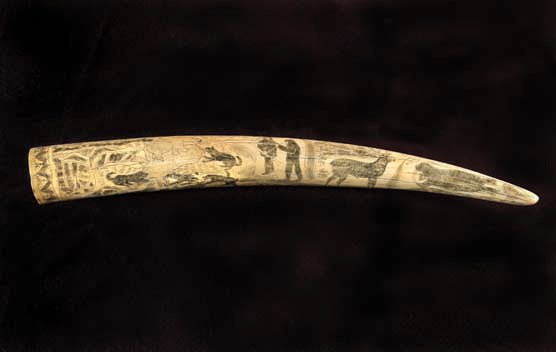
NPS Photo Scrimshawed Walrus Tusks The park recently accepted a generous donation from Mr. Richard Vignolo, a member of the San Francisco Maritime National Park Association, of beautiful scrimshawed walrus tusks. Hand scribed onto the tusks are scenes of men in boats hunting walrus, an arctic scene of dogs pulling a man on a sled, and the San Francisco whaling ship Jeanette, that was active in the Arctic whale fishery between 1893 and 1914. The Jeanette sailed out of San Francisco and was built at a shipyard in Benicia, California, by Matthew Turner, the most prolific shipbuilder on the West Coast during the 19th century. Also included in the donation are two carved Narwhal(ivory)walking canes. Mr. Vignolo’s grandfather operated a jewelry store in San Francisco on Dupont Street (now Grant Street) in the early 1900s and the pieces were reportedly traded there by sailors. The ivory canes will be displayed in upcoming exhibits planned for the Visitor Center.
Interesting Items Dug Up During Renovation Work During the renovation of the Aquatic Park Bathhouse, a number of items were found that provide a glimpse of life in the 1930s and perhaps before. Ceramic and glass sherds, found in the pit dug for the new elevator, may very well be part of the rubble of the 1906 Earthquake and Fire. A brown glass wine bottle, a Rainier beer cone-top can, an Orangeade bottle cap, and a tobacco bag, tell us of habits and vices of those who worked in, or on, the building. In the United States, cone top beer cans had their start in 1935. Prior to the 1930s most beer was bottled in glass. The cone top can design allowed breweries to use their existing bottling equipment to fill and cap the "bottle-shaped" cans. Because ot its design, we know that this particular can was made between March 1936 and July 1937 (the latter being the "brewed by" date on the bottom). Eventually the flat top beer can, that we use today, was introduced and new canning systems were devised to fill them. A Calo Cat Food can, found several years ago in the building, contains a residue of blue paint, a thumbprint in blue on the outside of the can, and, attached to the exterior, an intriguing hand-written notation: "flat blue fish/ panel #26." During the late 1930s artist Hilaire Hiler, and his assistants, spent two years creating 5000 square feet of brilliantly colored interior murals. We don't have absolute proof, but it seems likely that this paint was used to create one of the blue fish in a mural panel. Tours of the building and the murals are offered on a regular basis. Call the park Visitor Center for dates and times, 415-447-5000. By Judy Hitzeman, Museum Curator 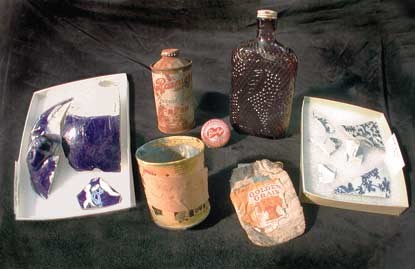
NPS Photo |
Last updated: December 8, 2024

